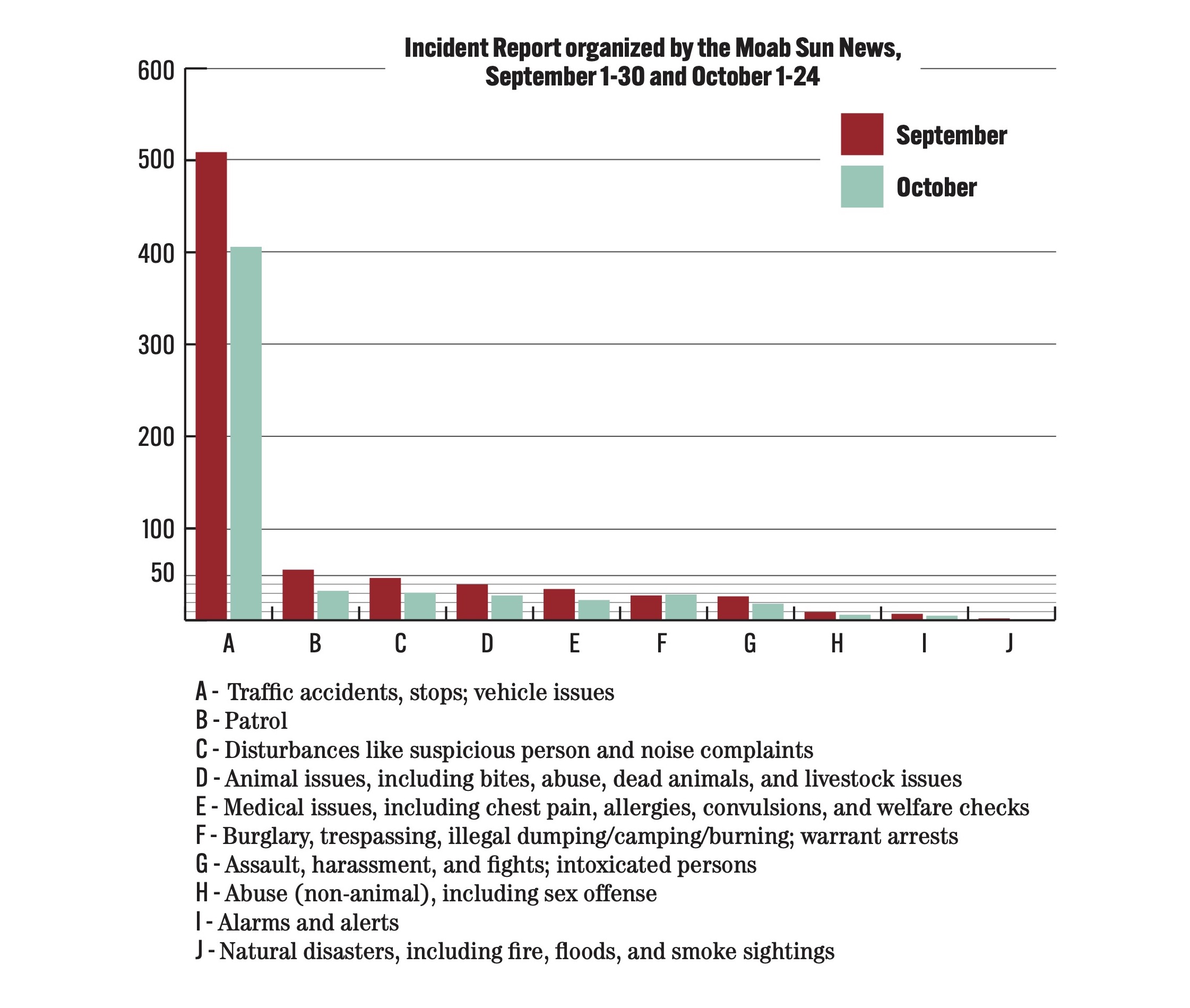Some information may be outdated.
New Chief Lex Bell will use data to guide department focus
Starting in early July, the Moab City Police Department began using the same software system as the Grand County Sheriff’s Office—called Spillman Flex—to track its computer-aided dispatch (CAD) data. Police Chief Lex Bell said it took a few months, until September, to clean up the software. But now, the department has a reliable way to track its data, and plans to share the data on a semi-regular basis.
Obviously, having reliable data is a good thing. Bell said he’ll use it to make department decisions, like identifying which incident types officers could use more training on, or where the department should focus its efforts. Looking at the data from September and October, he said, the department is spending most of its time addressing issues like traffic stops and parking problems, medical responses, intoxicated persons, found property, and reckless drivers.
In September, the department responded to 1,078 calls; in October, 814. Bell hopes as the software keeps collecting data, he can use it to point out trends—what incidents happen more when more tourists are in town? What are the hot spots in town?—and be able to show where more enforcement, or better training, can reduce the number of incidents.
Bell shared a “Chief’s Report” generated by Spillman Flex with the Moab Sun News. It doesn’t include the specifics of incidents, but categorizes them by type. If an incident falls into more than one category, it’s counted in each in the Chief’s Report.
The majority of those calls are traffic stops or hazards (509 in September, 406 in October); in September, the majority of traffic citations were for speeding (104), with the next highest citation being traffic control signal violations (7).
Bell plans to put together presentations of the data for the Moab City Council on a quarterly basis, he said.
The rest of the CAD data looks extremely similar to CAD data collected by the sheriff’s office. The city police department and county sheriff’s office have a “working relationship,” Bell said; in a perfect world, anything that happens in the city would be handled by the city police, anything in the county by the sheriff. But what often happens are agency assists— the department had 9 in September, 10 in October—where one agency will immediately respond, and the other will come after to help.
“We end up handling things for each other all the time, which isn’t a big deal—we’re all in the same county, we all work together,” Bell said. The data shows some distinction, though: since the sheriff’s office handles calls on I-70, they’re more likely to respond to narcotics interdiction, for example.
In a presentation to the Moab City Council on October 24, Bell highlighted incidents that were uncommon (there was one call listed under “bomb threat or attack” in September, and an aircraft crash in October) and higher frequency incidents (including traffic stops, code enforcement violations, and animal problems). He also marked incidents “possibly related to unhoused/transient population,” including “suspicious person,” “vagrancy,” and “illegal campers.”
“That tells me we need to keep working with our community partners,” Bell said. The department works closely with Moab Solutions and the Moab Valley Multicultural Center, he said, to assist people in finding housing options.
“With that many incidents,” Bell said, “we need to concentrate on that. How do we move forward? How do we help folks?”
Bell started as police chief at the end of September, when former chief Jared Garcia left the position. His main goal, he said, is to “keep the momentum going,” regarding staffing the department. The department is currently fully staffed, so now, Bell wants to focus on getting officers trained.
“My goal is not just to do a lot of training, but to do a lot of baseline, fundamental, master-the-basics training, so we can build to a master understanding,” he said. He wants to make department staff proactive to issues, instead of reactive.
He’s also hoping to bring a social worker on staff. The department’s victim advocates are “fantastic,” Bell said, but they can’t fully bridge the gap of connecting people to help.
“I think it’d be amazing to have that,” he said. “I’ve never worked anywhere that staffed a social worker, but I think that’s a trend we’ll start seeing more and more—it makes perfect sense.”
Appreciate the coverage? Help keep local news alive.
Chip in to support the Moab Sun News.





